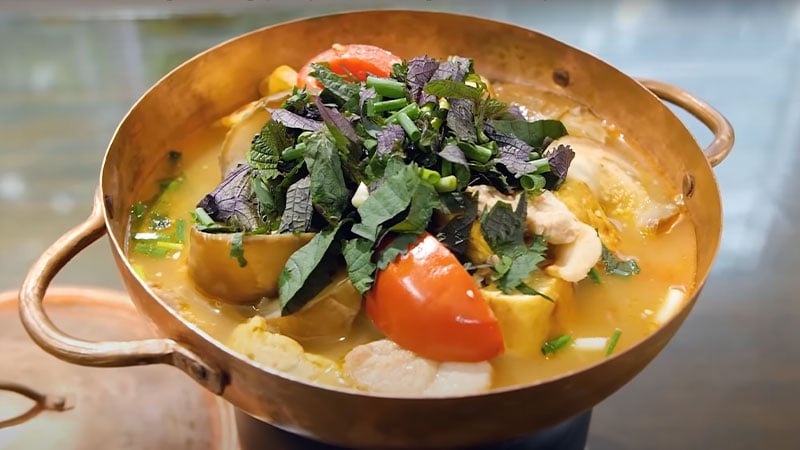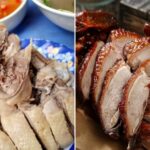Eggplant and green tomatoes are a staple in Vietnamese cuisine, with their unique sweet and sour flavors. A traditional dish, “Cà bung”, is a delicious stew made with these vegetables, pork belly, and a special ingredient – “me” (fermented rice).
In traditional Eastern medicine, eggplant and green tomatoes are believed to have cooling properties and a sweet taste. They are said to have anti-inflammatory, blood-dispelling, and digestive health benefits, as well as supporting kidney function. However, raw eggplant contains high levels of the toxic compound solanine, up to 5-10 times the safe limit. Even when cooked at high temperatures, improper handling can result in retained solanine, leading to health issues ranging from nausea to diarrhea or hallucinations.

Cà bung – A Hearty Vietnamese Stew
The key to making cà bung lies in the addition of ‘me’, a type of fermented rice. ‘Me’ contains lactic acid, which neutralizes the solanine in raw eggplant, making the dish safer for both children and the elderly. Moreover, ‘me’ adds a distinctive mild sourness and natural sweetness to the dish, creating a well-balanced flavor profile. When blended with the creamy eggplant and fatty pork belly, it produces a subtle, appealing thickness.
A dash of shrimp paste enhances the flavor of cà bung. In Vietnamese culinary tradition, it is believed that “meat without onion and soup without shrimp paste lack flavor.” The combination of shrimp paste and lactic acid from ‘me’ creates amino acids with a lingering sweetness, resulting in a harmonious taste that soothes the palate.
The term ‘Bung’ refers to a cooking method for watery dishes, as mentioned in the 1925 Hanoi publication, ‘A Book of Teaching How to Cook for Feast’. It is used for dishes such as ‘Bún bung’ and ‘Cà bung’, similar to the methods of cooking ‘Riêu’, ‘Thuôn’, ‘Ám’, and ‘Xáo’.
Selecting and Preparing Eggplant: Choose eggplants with a deep purple, smooth, bright color, that feel heavy for their size, and have fresh green stems. Remove the stems, cut the eggplants into wedge-shaped pieces, and soak them in a dilute salt water solution with a splash of vinegar, ‘me’, or lemon juice for 30 minutes. This process helps to maintain the whiteness of the eggplant, prevents discoloration, and reduces toxins.
Other Ingredients: Cut the tomatoes into wedges, strain the ‘me’ through a sieve, and grind the turmeric to extract its juice. Lightly crush the garlic, and finely chop the scallions, perilla, and leaf lolot. For the most authentic flavor, use tofu that has been grilled over charcoal. If unavailable, cut the tofu into bite-sized pieces and pan-fry them.
Cooking the Dish: Marinate the pork belly with fish sauce, shrimp paste, turmeric juice, and pepper. Sauté the marinated pork belly with the aromatics until lightly browned. Add the tomatoes and continue cooking briefly before adding water to just cover the ingredients. Simmer over low heat.
Add the eggplants to the pot, along with the remaining turmeric juice and ‘me’, adjusting the seasoning to taste. Continue cooking for 10-15 minutes. When the eggplants turn slightly translucent, add the fried tofu and cook for a few more minutes to allow the flavors to meld.
Final Touches: Toss in the scallions, perilla, leaf lolot, and crushed garlic, stirring to combine. Turn off the heat and serve the hearty stew.
Notes: The use of tomatoes and garlic may vary depending on regional preferences. Some regions prefer to pan-fry the eggplants first to retain their texture, while others cook them directly in the stew for a more rustic flavor. Cooking the stew over low heat allows the flavors to infuse thoroughly, resulting in a tastier dish.
Cà bung is not just a traditional dish with a rich flavor profile but also a nutritious meal when prepared correctly. By following these tips, you can create a delicious and safe cà bung that will satisfy your taste buds and nourish your body.
The Ultimate Guide to Eggplant Preparation: A Chef’s Secrets Unveiled
The aubergine, or eggplant, is a versatile vegetable with a unique taste and texture. This article will reveal tips and tricks to prepare and cook aubergine to perfection, enhancing its natural sweetness and reducing any bitterness. Discover the secrets to unlocking the full potential of this nutritious vegetable with our expert guide.
The Tasty Duck Meat: Avoid These Four Food Combinations to Stay Healthy
Duck meat is a nutritional powerhouse, offering a plethora of health benefits, particularly for cardiovascular health. It is a versatile ingredient used in myriad delectable dishes. However, there are a few considerations to keep in mind to ensure you reap the benefits without any adverse effects on your health.



































